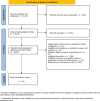Comparative efficacy of topical interventions for facial photoaging: a network meta-analysis
- PMID: 40707570
- PMCID: PMC12289910
- DOI: 10.1038/s41598-025-12597-0
Comparative efficacy of topical interventions for facial photoaging: a network meta-analysis
Abstract
Chronic ultraviolet (UV) exposure is the primary cause of skin photoaging, leading to wrinkles, pigmentation changes, and loss of dermal elasticity. This systematic review and network meta-analysis evaluated the efficacy and safety of topical compounds for treating skin photoaging. A comprehensive search identified 23 RCTs with 3905 participants, comparing anti-aging agents. Bayesian network meta-analysis showed isotretinoin, retinol, and tretinoin significantly improved fine wrinkles, with isotretinoin ranked highest. Tazarotene was most effective for coarse wrinkles, while glycolic acid reduced roughness. Tretinoin and retinol were superior for hyperpigmentation. Safety analysis indicated tretinoin had the most favorable profile, whereas tazarotene and glycolic acid had higher adverse event risks. Isotretinoin and tretinoin emerged as the most balanced treatments across efficacy and safety. These findings provide evidence-based guidance for clinical decision-making in anti-photoaging therapy and underscore the potential for these agents to be integrated into routine dermatologic practice, particularly for patients seeking effective and well-tolerated topical interventions. However, limitations included limited racial diversity, potential commercial bias, and variability in dermatological assessments. These findings provide evidence-based guidance for clinical decision-making in anti-photoaging therapy.
Keywords: Efficacy; Network meta-analysis; Safety; Skin photoaging; Topical compounds.
© 2025. The Author(s).
Conflict of interest statement
Declarations. Competing interests: The authors declare no competing interests. Ethical approval and statement: This meta-analysis has not obtained written patient consent for publication,therefore ethical approval and an ethics statement regarding patient consentfor publication are not applicable.
Figures






Similar articles
-
Interventions for photodamaged skin.Cochrane Database Syst Rev. 2005 Jan 25;(1):CD001782. doi: 10.1002/14651858.CD001782.pub2. Cochrane Database Syst Rev. 2005. Update in: Cochrane Database Syst Rev. 2015 Jun 02;(6):CD001782. doi: 10.1002/14651858.CD001782.pub3. PMID: 15674885 Updated.
-
Interventions for rosacea.Cochrane Database Syst Rev. 2015 Apr 28;2015(4):CD003262. doi: 10.1002/14651858.CD003262.pub5. Cochrane Database Syst Rev. 2015. PMID: 25919144 Free PMC article.
-
Systemic pharmacological treatments for chronic plaque psoriasis: a network meta-analysis.Cochrane Database Syst Rev. 2021 Apr 19;4(4):CD011535. doi: 10.1002/14651858.CD011535.pub4. Cochrane Database Syst Rev. 2021. Update in: Cochrane Database Syst Rev. 2022 May 23;5:CD011535. doi: 10.1002/14651858.CD011535.pub5. PMID: 33871055 Free PMC article. Updated.
-
Topical anti-inflammatory treatments for eczema: network meta-analysis.Cochrane Database Syst Rev. 2024 Aug 6;8(8):CD015064. doi: 10.1002/14651858.CD015064.pub2. Cochrane Database Syst Rev. 2024. PMID: 39105474 Free PMC article.
-
Systemic pharmacological treatments for chronic plaque psoriasis: a network meta-analysis.Cochrane Database Syst Rev. 2017 Dec 22;12(12):CD011535. doi: 10.1002/14651858.CD011535.pub2. Cochrane Database Syst Rev. 2017. Update in: Cochrane Database Syst Rev. 2020 Jan 9;1:CD011535. doi: 10.1002/14651858.CD011535.pub3. PMID: 29271481 Free PMC article. Updated.
References
-
- Tang, Z. et al. Research progress of keratinocyte-programmed cell death in UV-induced skin photodamage. Photodermatol. Photoimmunol. Photomed.37, 442–448 (2021). - PubMed
-
- Gilchrest, B. A. A review of skin ageing and its medical therapy. Br. J. Dermatol. 1996. 135, 7–75 (1996). - PubMed
-
- Tang, Z. et al. Research progress of keratinocyte-programmed cell death in UV-induced Skin photodamage. Photodermatol. Photoimmunol. Photomed.37, 442–448. 10.1111/phpp.12679 (2021). - PubMed
Publication types
MeSH terms
Substances
Grants and funding
LinkOut - more resources
Full Text Sources
Medical

